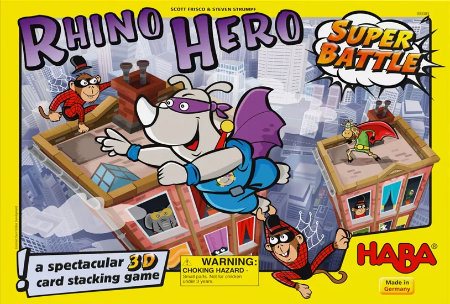Rhino Hero: Super Battle Board Game Review

By MARK WILSON

Year Published: 2017
Players: 2-4
Playing Time: 10-30 Minutes
I was about to write that stacking games have a storied history, but that would be me puffing them up more than they should be.
They’re a type of game. There, how’s that for truth in media?
Broadly speaking, you put one thing on top of another until your structure falls. This, to many, is quite fun.
Jenga is probably the most well-known of these. It’s stacking, yes, but the pieces you’re stacking are also being pulled from the structure itself. So the higher it goes, the more you’re compromising its integrity.
Others will offer different wrinkles. A failure doesn’t mean game over, but you may have to use fewer fingers or your non-dominant hand next time. Other times the nature of what you’re stacking creates spatial challenges. For instance, Jenga’s blocks are all shaped the same, but in a game like Animal Upon Animal, they’re anything but.
Others still will hit you with particular challenges of how you need to stack things.
Rhino Hero: Super Battle is…another of these. It iterates on 2011’s Rhino Hero by expanding it both outward and upward, in ways both literal and conceptual. In it, you have a “superhero” figure that climbs (up and down) an expanding structure you’ll be building with wall and floor/roof cards. Topple the tower by accident and you lose. Have your hero on the highest level of the structure when it topples (or when you run out of cards to stack) and you win. Simple stuff.
The Super and the Superfluous
I may have sounded unimpressed there in my introduction. Let me add some superlatives to correct that: Rhino Hero: Super Battle can be tons of fun!
The good part is that Rhino Hero remembers that tension is created in this type of game by having a memorably sprawling structure. The tools it gives you to do this are appropriately large and colorful.
The less good part is that there’s some silly, superfluous stuff added into the mechanics that many will find themselves indifferent to.
Let’s Talk About Dice Rolls and Monkeys
On your turn, after stacking something onto the central tower, you’ll roll a die, and this will dictate the movement of your hero. If you end on the same level as another hero, you have a roll-off “battle” and one of you will be moving down a tier.
This is dumb and silly, but it also works within the game’s light mechanical structure. The stacking is the point here. Whether or not you roll well shouldn’t be the point.
This will irk some who don’t want entirely random outcomes dictating their games, but it’s here that I think we need to examine why we play games. If the only answer is “to win,” move along. This isn’t your game.
Next are the monkeys. Some cards will have monkey symbols on them, which ask you to hang one of a handful of monkey tokens from floors of the building. Ostensibly, this is to give you another chance to accidentally topple the tower. In practice, though, with no true penalty for a monkey falling (you just put it back on), it amounts to busywork.
This is dumb and silly, but not of the good, thematic kind like the dice rolls. They could be house-ruled away and I don’t think the game would be any worse for it.
The Importance of Being Memorable
Games are memory generators. Not solely, of course. But this is an important function of them. Gamers will enthusiastically tell you about their most memorable sessions.
While I sometimes decry things like artwork and component quality in games, grumbling that I don’t need excessive opulence to enjoy myself, one of the ways (some) games can create lasting memories is through their visuals.
Rhino Hero: Super Battle’s components are colorful and sturdy, though not spectacular. However, what can be spectacular are the towers you create.
This is perhaps the most photogenic game I’ve ever played. It’s certainly the most photogenic in my personal collection. I have not been able to play a session without players pulling out their phones to snap a pic before the tower crumbles.
Sometimes these pictures aren’t even being taken by those in the game. It will attract onlookers in all but the most mirthless settings.
And so when you collaboratively build a tower that, for example, you struggle to even reach the top of (I once had to stand on a chair to place new cards in the tower), it’s an experience, in the best way possible. Even better, if the game ends dramatically with a toppling, epic tower, it’s sure to induce laughter and create lasting memories.
This is what RH:SB does best for me. It’s a weird, slightly clunky game when you look at some of its component parts like the dice rolling and monkeys…which, let’s be honest, are rarely too memorable. But the game as a whole surely is memorable when it’s clicking…
The Letdown of Being Anticlimactic
…I ended that last section with “when it’s clicking” for a reason. That reason being, it doesn’t always work as intended.
The biggest culprit is the fact that even a slight topple of part of the tower is enough to trigger the game’s end. And that isn’t terribly dramatic, is it?
Of course not. You want to see the entire, massive thing crumble to the ground in a messy blaze of glory!
Worse yet, if the tower never topples, the game end could be triggered simply by running out of cards to stack. At that point, whichever of your heroes is highest on the tower’s levels is the winner.
Boring, is what that is. I want tension! I want drama! I don’t want “oh, we’re done? I guess Andrea wins; her hero is the highest.”
House Ruling and Expanding
I cheated with this game. I didn’t cheat at playing it, mind you, but I cheated in how I play it with others. Because what I play isn’t exactly what’s in the box.
Because, you see, I saw what the game wanted to be, and I helped it achieve that vision.
So I bought a second copy of the game and merged them into one.
This accomplishes a few things:
- Because of the extra cards, the game is basically guaranteed never to end without the structure toppling. This increases the drama.
- The structures are wider, taller, and more impressive. This increases the toy factor considerably.
- It allows for weird configurations of starting slabs at the bottom from which you build, so that you can create unique and varied structures that defy the regular game’s limitations. This again creates some visual interest in ways that few other games can even approach.
So if my praise for Rhino Hero is marred for you by the fact that I’m doubling the number of components in the game, so be it. I don’t consider game designs to be untouchable monoliths, and the expanded game (I allow it to go to 5P with the extras, though not more) has turned it into one I want to keep in my collection, whereas before it was teetering on that line of “keep or sell.”
The heady, memorable stuff is here, as is the silly, forgettable stuff. It coexists, and if you’re unlucky, the forgettable stuff will be more prominent in a session. I’ve minimized this with my double copy (they both easily fit in a single box).
For those unwilling to do that, though, I think this is still a fun game and worthy consideration for purchase. But it’s also not a slam dunk recommendation from me unless you’re willing to do what I did with dual purchases, since your experience is more likely to be uneven, and the most hilarious highs – which will happen in any version, for clarity – will be tempered with instances of anticlimactic sessions.
…
Like my content and want more? Check out my other reviews and game musings!
Read More From Bumbling Through Dungeons
Recent Posts
Categories
- All (338)
- Announcements (4)
- Board Games (199)
- DMing (28)
- Game Design (16)
- Playing TTRPGs (14)
- Reviews (186)
- RPGs (141)
- Session Reports (83)
- Why Games Matter (9)